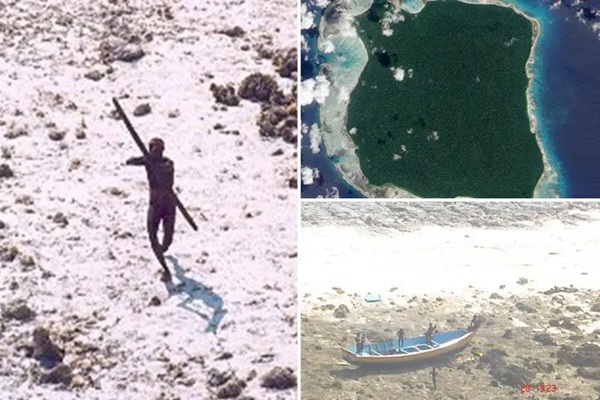A few places on earth remain almost untouched by modern influence. Though satellites cover the planet and aircraft cross the skies each day, there are still regions where time appears to stand still. One of the most remarkable of these is North Sentinel Island. It lies in the Bay of Bengal and is part of India’s Andaman and Nicobar archipelago. While the island is small in size, its history and strict isolation have made it one of the most studied yet least understood places in the world.
The people who live there are known as the Sentinelese. They maintain strict independence from the outside world and reject any form of outside contact. Their culture, language, and daily life remain largely unknown. For decades, governments, researchers, and curious travelers have learned the same lesson. The island cannot be approached, its people cannot be visited, and no one is permitted to enter or leave.
This article examines the history of North Sentinel Island, what is known about its people, why their isolation is protected, and what this unusual place represents in today’s world.
Geographical Background
North Sentinel Island lies west of the main Andaman Islands. Its landscape consists of dense forest, narrow beaches, and a protective coral reef that surrounds most of its coastline. The reef creates a natural barrier that prevents boats from coming close. The island covers about sixty square kilometers, but most of it is thick tropical woodland. The combination of trees, rugged terrain, and shallow waters makes the island difficult to reach even for experienced navigators.
The Indian government administers the wider Andaman and Nicobar region. However, North Sentinel Island is governed under a special policy of complete protection. It is marked as a restricted zone, and approaching the island is illegal.
Who Are the Sentinelese?
The Sentinelese are considered one of the last uncontacted peoples on earth. Their ancestry is believed to trace back tens of thousands of years. Anthropologists believe they may be related to other indigenous groups in the Andaman Islands, such as the Jarawa and the Onge. However, while some Andaman groups have had limited interaction with outsiders, the Sentinelese have remained almost entirely isolated.
The community is estimated to number between fifty and one hundred fifty people. Because the island cannot be entered, no precise count is available. Their language is unknown. There are no recorded dictionaries, no comparative linguistic studies, and no known translation of even a basic word. The few attempts by researchers to communicate through gestures produced little clarity.
Their culture is also mostly speculative. Observations from a distance suggest that they rely on hunting, gathering, and fishing. They use simple tools and build small dwellings within the forest. Unlike some other island communities, the Sentinelese are not known to practice agriculture. Their diet is believed to include wild plants, fish, turtles, and possibly birds or small animals.
What stands out most is their independence. The Sentinelese do not seek help, trade, or cooperation with the outside world. For them, isolation is not a temporary choice but a way of life that has persisted for centuries.
Historical Attempts at Contact
There have been attempts to contact the Sentinelese, though none resulted in peaceful or lasting communication. Many of these efforts were made before modern restrictions were introduced.
Early Colonial Encounters
British colonial authorities explored the Andaman Islands in the nineteenth century. They attempted to establish relations with local groups, often with mixed results. In 1880, an expedition led by Maurice Vidal Portman reached North Sentinel Island. The group located a few temporary shelters but did not encounter the inhabitants directly at first.
Later, Portman and his team captured several Sentinelese individuals, including an elderly couple and a few children. They were taken to Port Blair, the administrative center of the Andamans. The adults became ill and died shortly after. The children were returned to the island with gifts. This event marked one of the earliest recorded contacts and also demonstrated the danger of exposing isolated populations to outside diseases.
The Twentieth Century
For much of the twentieth century, there were no regular attempts at interaction. The island remained outside public attention, and navigation challenges kept most visitors away. Occasional sightings of Sentinelese individuals were reported by passing ships, but no sustained engagement took place.
In the 1970s, the Indian government began surveying the region more systematically. Small groups of anthropologists and officials attempted controlled visits. These consisted of leaving items such as coconuts or tools on the shore while staying in boats. At times, the Sentinelese allowed the gifts to be collected. At other moments, they greeted the visitors with weapons.
One of the most notable figures involved in these efforts was the Indian anthropologist T. N. Pandit. For several years, his team made cautious attempts to approach the island. In the early 1990s, a brief moment of progress occurred when Sentinelese individuals allowed the researchers to place coconuts on the beach. Yet the interactions remained distant and unpredictable. Pandit later concluded that the community preferred isolation and that further attempts would bring more harm than good.
Termination of Contact Efforts
By the mid-1990s, Indian authorities stopped all attempts at contact. The goal shifted toward strict protection of the community, recognizing that contact risked spreading disease and disrupting their way of life.
Events That Reinforced Isolation
Several incidents over the years demonstrated how firmly the Sentinelese defend their territory. These events further justified the decision to restrict access.
The 2004 Tsunami
After the Indian Ocean tsunami of 2004, officials feared that the Sentinelese may have suffered heavy losses. A helicopter was sent to check on the island. When it flew over, several Sentinelese emerged from the forest and shot arrows at the aircraft. This confirmed that the community had survived and did not wish to receive help.
The 2006 Fishermen Incident
In 2006, two fishermen drifted onto the island after their boat’s anchor failed. They were killed by the Sentinelese and buried on the shore. The incident occurred because the fishermen had entered prohibited waters. Efforts to recover the bodies were abandoned to avoid further conflict.
The 2018 Death of an American Visitor
In 2018, a young American traveler named John Allen Chau attempted to reach the island without permission, hoping to spread Christianity. He paid local fishermen to take him to the restricted zone and approached the shore in a small boat. The Sentinelese responded by shooting arrows. Chau died after repeated attempts to land. The event drew global attention to the island’s policies and reinforced the need to respect its isolation.
Why Outsiders Are Banned from Entering
The restrictions surrounding North Sentinel Island are not meant to punish curiosity. They are designed to protect a vulnerable community and to prevent unnecessary loss of life. There are three principal reasons for the ban.
1. Disease Risk
The Sentinelese have had almost no exposure to global pathogens. Even common viruses could be devastating. Historically, indigenous communities have suffered catastrophic losses when exposed to outside diseases. Because the Sentinelese population is small and has limited immunity, the results of sudden exposure could be severe.
2. Cultural Preservation
The Sentinelese maintain a way of life shaped over thousands of years. Outside contact would inevitably influence their culture. Even small interactions could disrupt their social structure, economy, or traditions. Many anthropologists believe that their isolation must be respected for ethical reasons.
3. Safety of Outsiders
The community has made it clear that they do not welcome visitors. Anyone who approaches the island risks injury or death. The Indian government enforces a buffer zone around the island to prevent accidents and unauthorized travel.
Why the Sentinelese Do Not Leave the Island
The notion that no one leaves North Sentinel Island is based on observation, not rule. The Sentinelese have never shown interest in seeking outside contact or exploring beyond their environment. Several factors may contribute to this.
Geographical barriers make travel difficult. The coral reef and the lack of modern boats restrict long-distance movement.
Cultural self-sufficiency also plays a role. The Sentinelese appear to have everything they need within their environment. They hunt, gather, fish, and thrive without modern technology.
Historical experience might also influence their behavior. The early encounters with outsiders were negative and may have strengthened their desire for isolation.
The Island in Modern Policy
North Sentinel Island is now protected under Indian law. Visitors are prohibited from approaching closer than several nautical miles. Surveillance is conducted at a distance, and fishermen in the region are warned to avoid the area.
The government’s policy is guided by a principle known as “hands-off protection.” This means that the Sentinelese are not forced to integrate, and their territory is respected. They are recognized as a distinct tribal group with the right to live undisturbed.
What the Island Represents Today
North Sentinel Island raises important questions about human diversity, cultural autonomy, and ethical research. In an age when global contact is common, the Sentinelese remind the world that not all peoples seek participation in global society. Their choice to remain separate challenges modern assumptions about progress.
The island also serves as an example of responsible policy. Rather than pushing for assimilation, authorities have accepted that some communities thrive best on their own terms.
For researchers, the Sentinelese highlight the limits of knowledge. Much about their culture will remain unknown, yet their existence enriches the broader understanding of human history.
For the general public, the island stands as one of the last places where isolation is complete and where an ancient way of life continues without external interference.
North Sentinel Island is one of the most protected and mysterious places in the world. It is home to a community that has resisted outside contact for centuries and continues to guard its independence. Outsiders are not allowed to enter, and the Sentinelese do not leave. This arrangement safeguards their health, preserves their cultural identity, and prevents conflict.
While much about the island remains unknown, its story is widely recognized. It teaches respect for cultural boundaries and emphasizes the importance of preserving vulnerable communities. In a world where information travels quickly and borders are increasingly open, North Sentinel Island stands as a rare reminder of the value of privacy and self-determination.









